5 Issues Driving Ocean Conservation
During Capitol Hill Ocean Week, experts will discuss strategies to protect global waters
This analysis has been updated to reflect that the Port State Measures Agreement entered into force on June 5, 2016.
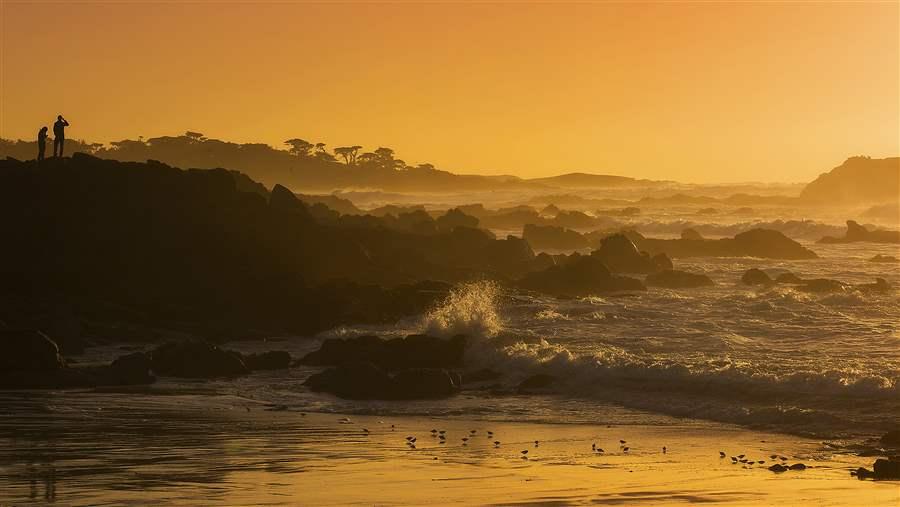 © Chase Dekker Wild-Life Images
© Chase Dekker Wild-Life ImagesPeople gather along the rocky coastline of Pebble Beach, California, to watch the sun set over the Pacific.
June is a big month for the oceans. Not only is it National Oceans Month, but World Oceans Day will be observed Wednesday, June 8, in the middle of Capitol Hill Ocean Week (CHOW), which runs June 7-9.
CHOW takes place annually in Washington and is one of the leading U.S. ocean conservation conferences, where advocates and experts gather to address important issues affecting marine ecosystems. The 2016 agenda will touch on ways to protect the oceans, from ending illegal fishing to establishing large marine protected areas. If you’re passionate about ocean conversation but can’t make it in person, you can join the live stream for sessions that interest you.
In anticipation of CHOW 2016, Pew is highlighting some of the key issues that will be discussed at the conference and our vision for addressing them.
The fight to end illegal fishing
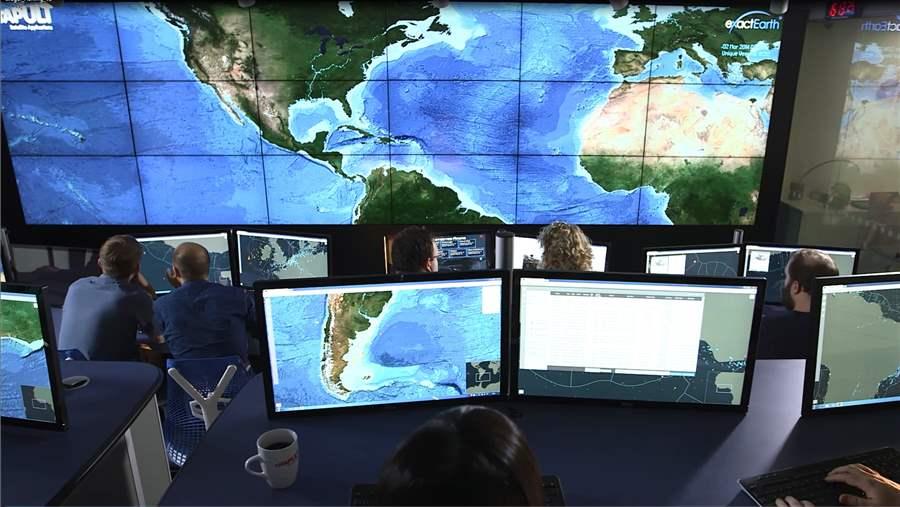 © Satellite Applications Catapult 2015
© Satellite Applications Catapult 2015Project Eyes on the Seas offers an efficient and cost-effective solution to problems related to ocean governance, enforcement, and monitoring.
This crusade made crucial progress on May 16, 2016, when the Port State Measures Agreement—an international treaty intended to help stop illegal fishing—passed after ratification by 30 countries, a number that exceeded the required threshold of 25 nations. The treaty entered into force on June 5, 2016.
Now we should build on this accomplishment.
Authorities still need cost-effective ways to monitor national waters and scan the vast oceans for suspicious activity. Pew’s Project Eyes on the Seas, launched in 2015 with the U.K.-based innovation center Satellite Applications Catapult, provides a way to do that.
The joint project helps fill in gaps in other monitoring platforms by combining and integrating multiple layers of data—including space-based radar, photographic imagery, and oceanographic information—to make sure vessels and questionable fishing operations are seen, regardless of whether they are properly transmitting their positions. Project Eyes on the Seas is especially helpful for countries that lack the resources to build such monitoring systems. Many of them are plagued by illegal fishing because they lack the capability to effectively patrol their waters.
A sustainable U.S. Arctic
A balance must be struck between responsible economic development and preservation of ecosystem integrity and function in U.S. Arctic waters. Some areas in the Beaufort and Chukchi seas warrant protection because they support wildlife migration routes, foraging hot spots, subsistence use, and seafloor and ice habitats.
Recognizing the importance of safeguarding especially sensitive habitat, President Barack Obama permanently withdrew 9.8 million acres of Arctic marine waters from oil and gas leasing in January 2015, as shown in the map below, under the Outer Continental Shelf Lands Act.

However, this work demands ongoing evaluation, in consultation with indigenous peoples and Arctic scientists, to identify other important areas in the Arctic Ocean that should be exempted from development to promote long-term sustainability. Ecosystem protection requires world-class industry standards that improve oil spill prevention, safety, and response.
The need for more marine reserves
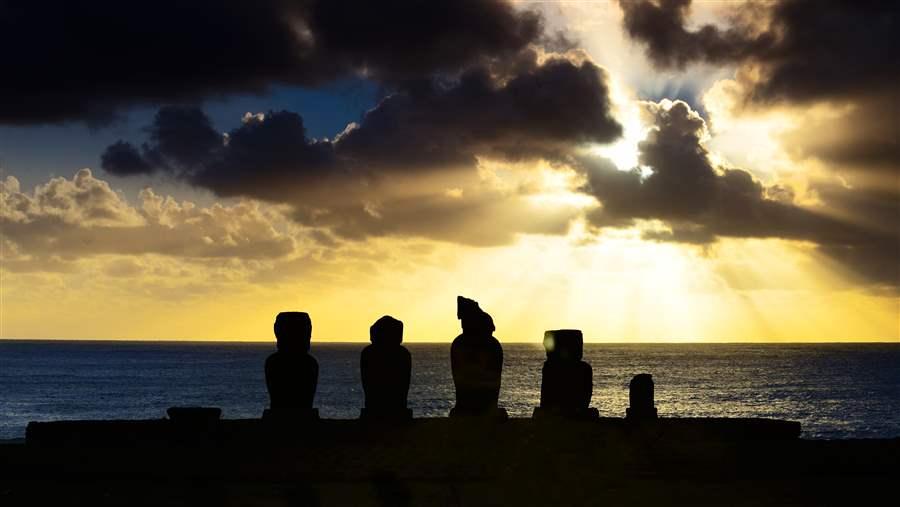 © Eduardo Sorensen
© Eduardo SorensenSeveral of Easter Island’s famous moai—giant, centuries-old statues—stand watch over the Chilean territory. On Oct. 5, Chile’s president, Michelle Bachelet, pledged to work with the indigenous Rapa Nui community to create a fully protected marine park in the island’s Pacific waters.
Scientists recently examined relevant studies of the world’s oceans and found that at least 30 percent needs protection. Despite landmark designations in 2015, only about 2 percent of the ocean is set aside as fully protected. Marine protected areas, particularly fully protected marine reserves, ensure that all fishing and other damaging uses are banned.
The United Nations’ Convention on Biological Diversity set a target in 2010 to conserve at least 10 percent of coastal and marine areas by 2020. In 2015, the U.N. also adopted this percentage as part of its Sustainable Development Goals. But these figures fall far below the scientifically recommended 30 percent level.
Each country has the right to set aside ocean areas within its exclusive economic zone (EEZ)—waters extending no more than 200 nautical miles from the shoreline. The 10 percent by 2020 goal could be met in national waters alone if nations protected 24 percent of their EEZs.
Another way to reach the 30 percent protection mark is to identify and designate areas in the high seas. These “global commons”—areas used freely by all but owned by no one—make up 64 percent of the ocean.
A strategy for healthy U.S. fish populations
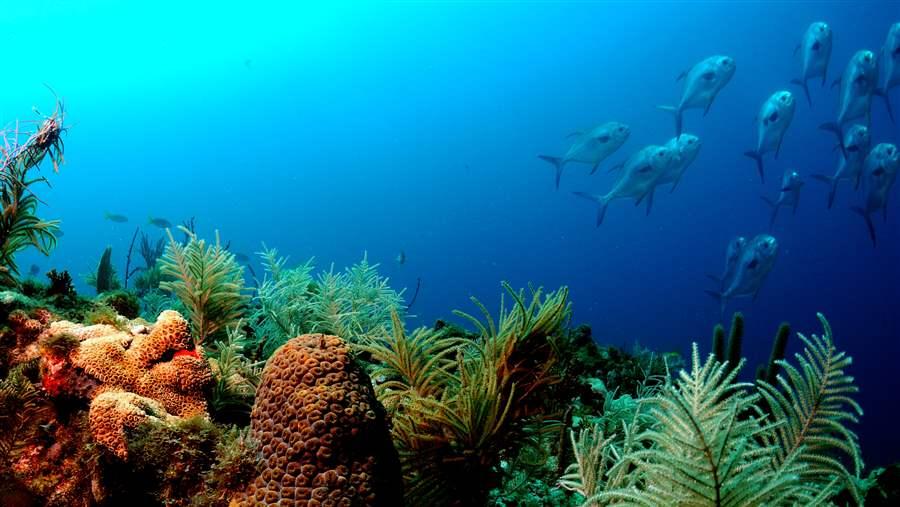 © NOAA
© NOAAThe Dry Tortugas Ecological Reserve provides safe habitat that helps fish populations thrive.
The Magnuson-Stevens Act, the primary law that governs fishing in U.S. ocean waters, turned 40 this year. But a lot has changed since the mid-1970s, from technological advancements to ocean warming and acidification, and the law is now up for reauthorization.
To manage U.S. ocean fish populations more effectively and sustainably, policymakers must look at the bigger picture.
This means that when Congress updates the act, it should adopt a more comprehensive, ecosystem-based approach, including specific actions rooted in the latest science that can help keep fish populations healthy:
- Protect forage fish.
- Conserve fish habitat, such as deep-sea corals off the Atlantic coast.
- Devise nets that can minimize bycatch, the unintended catch of nontarget fish and other wildlife.
- Require fishery managers to proceed with caution before permitting fishing in new areas.
- Develop road maps for fishery management.
A solution to safeguard shorelines
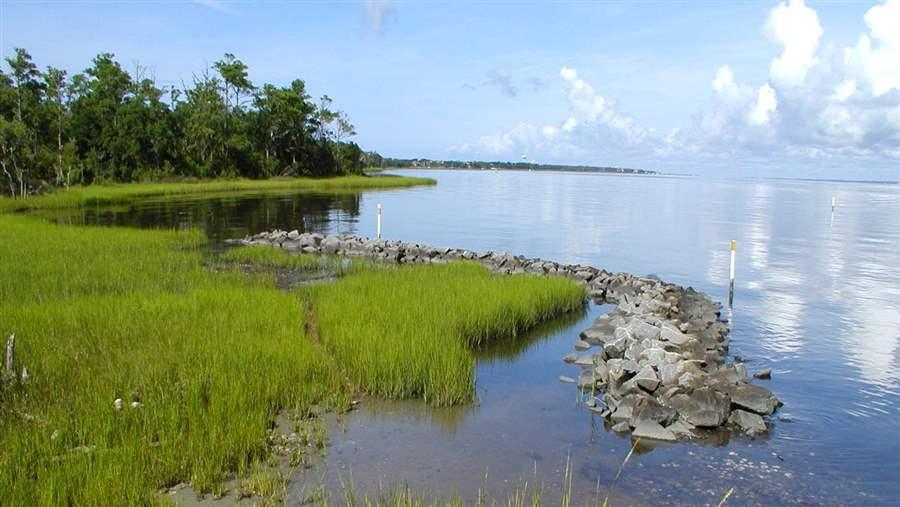 © Tracy E. Skrabal
© Tracy E. SkrabalA stone sill with marsh plantings successfully stabilized an eroding shoreline at the North Carolina Aquarium at Pine Knoll Shores.
Severe storm events are becoming more frequent, and weather-related catastrophes leave a path of physical and emotional destruction in their wakes.
The high concentration of people and property near U.S. shorelines also has some negative environmental consequences. Landowners built infrastructure, such as bulkheads or sea walls, as a solution to erosion and sea-level challenges. But this hardening of the shorelines has caused loss of wetlands and natural habitats and is often ineffective.
Living shorelines, which use a range of natural stabilization techniques—commonly involving the strategic placement of plants, stone, sand, and other materials—provide a proven and cost-effective alternative to structural approaches.
These nature-based solutions prevent erosion along estuarine coasts, bays, sheltered coastlines, and rivers while maintaining the land-and-water connection that is important for sustaining habitats for fish and wildlife, filtering pollutants from stormwater runoff, absorbing storm surge, and protecting land from wave energy.








